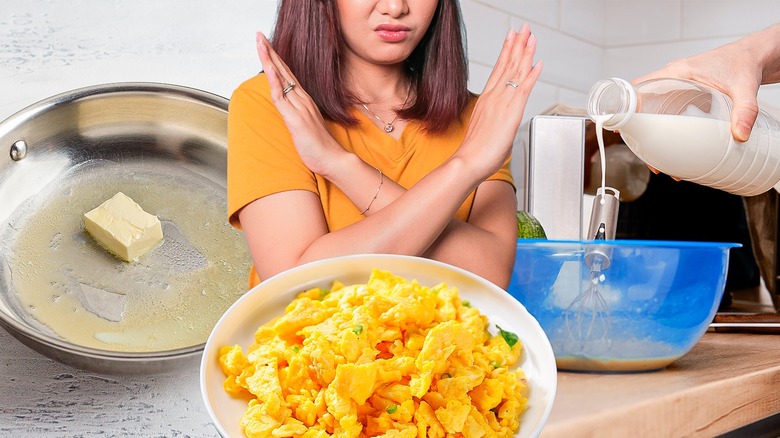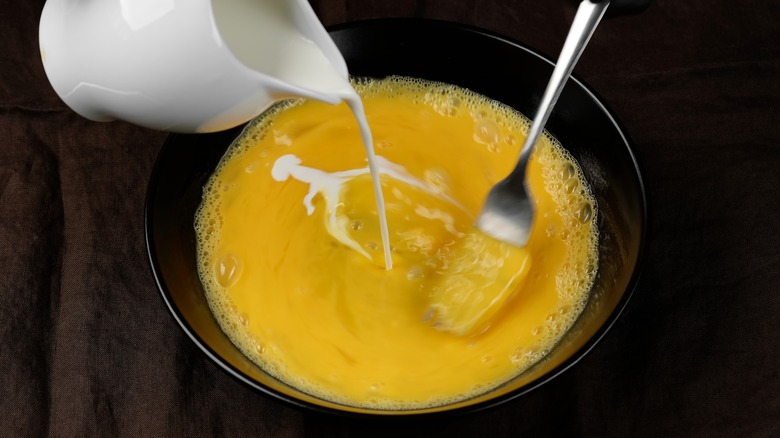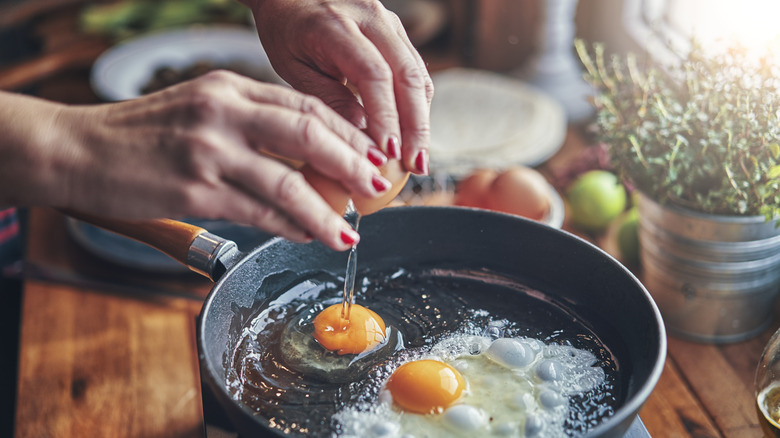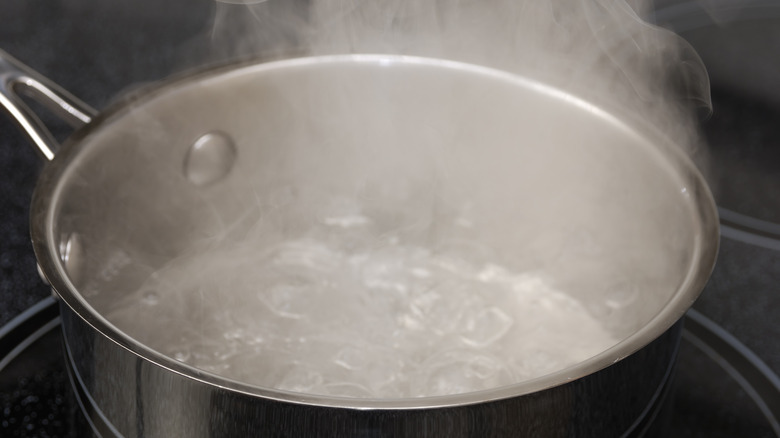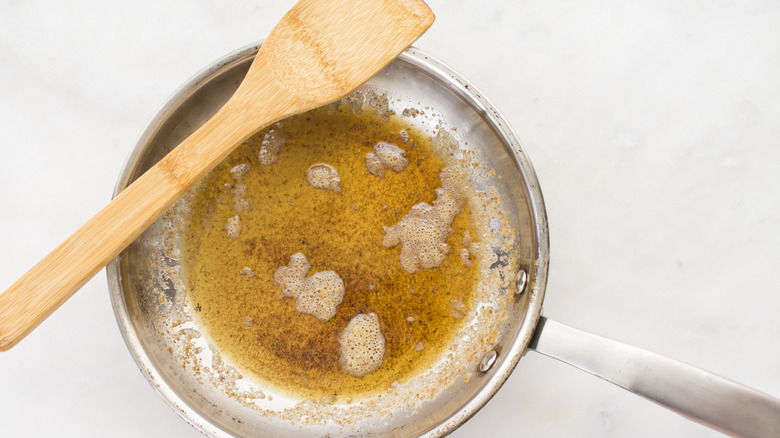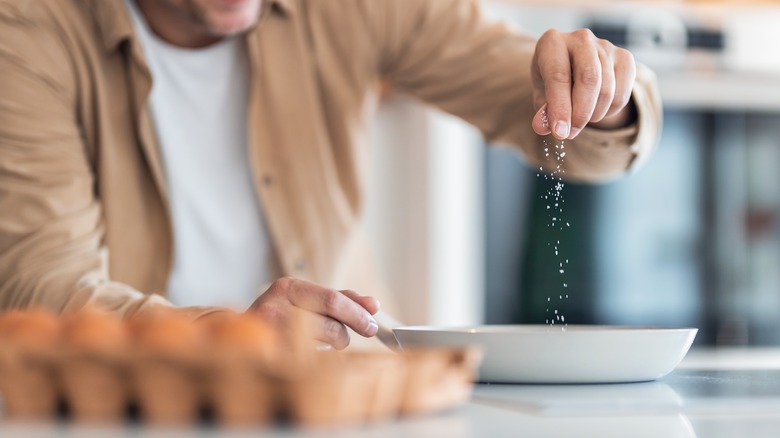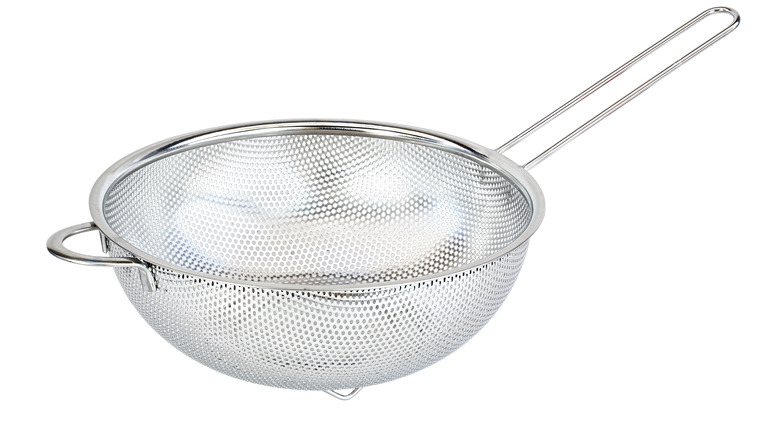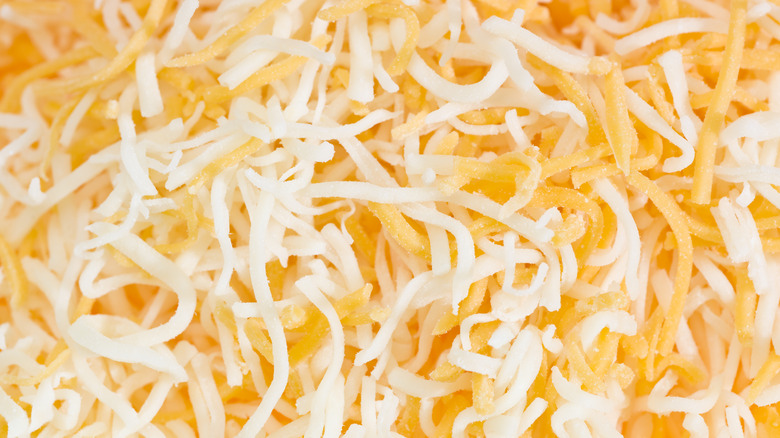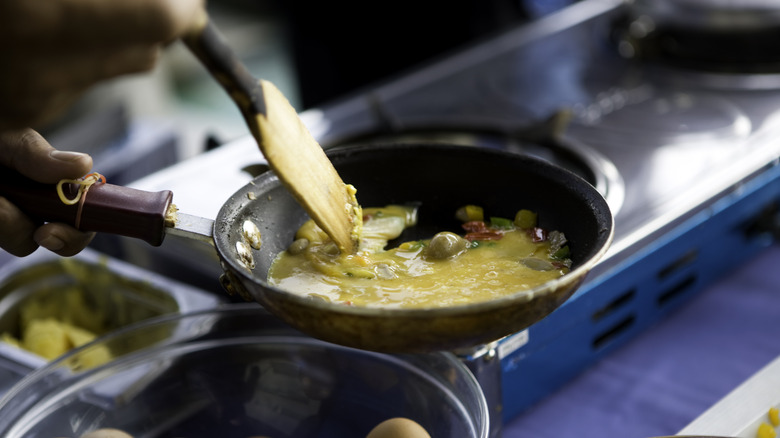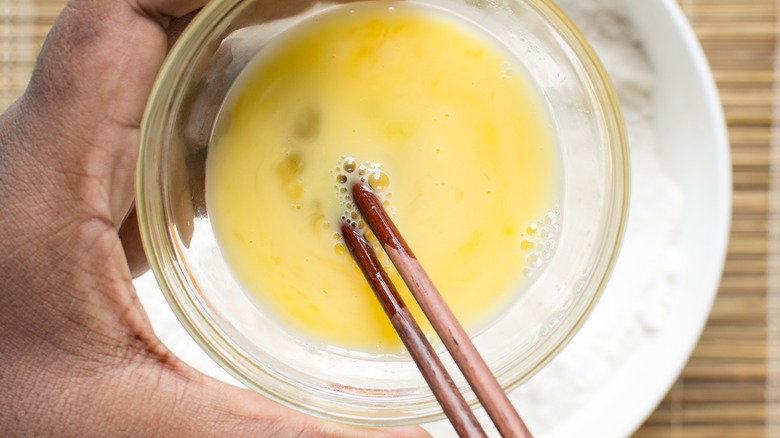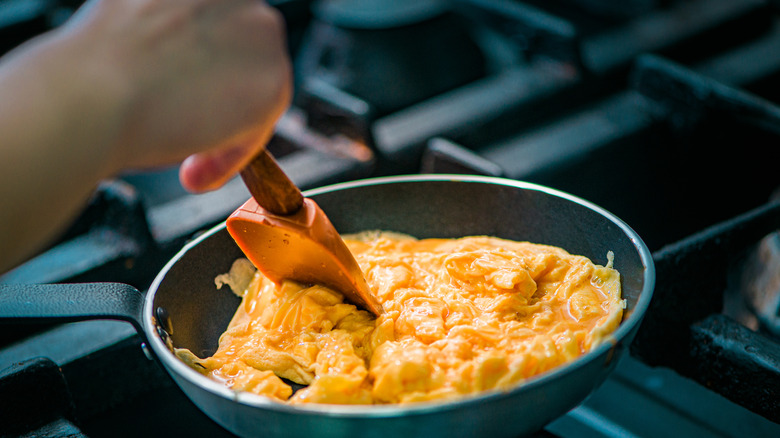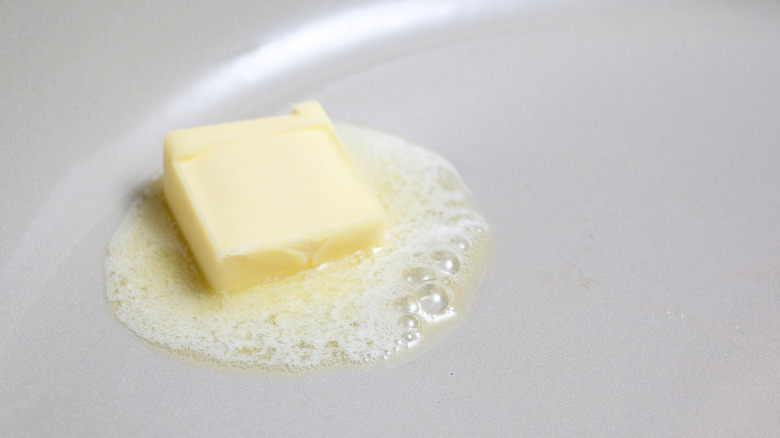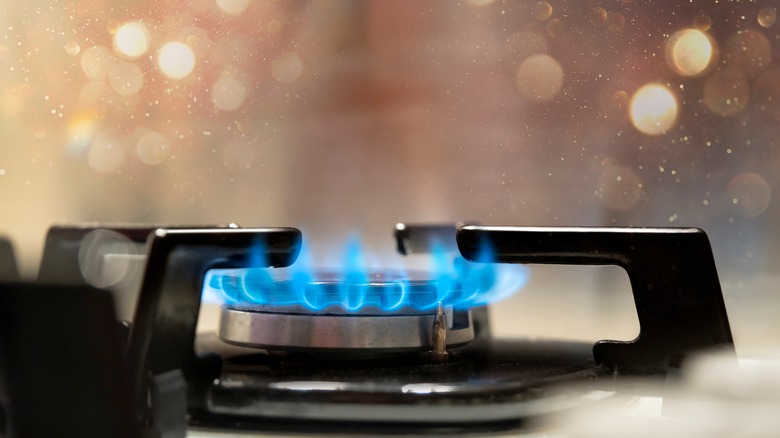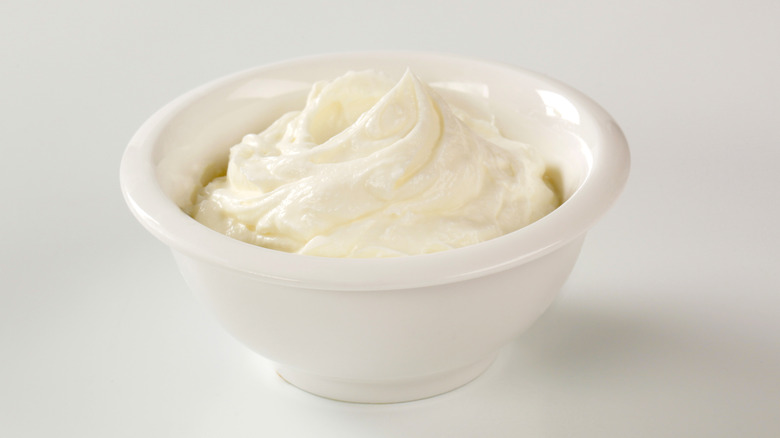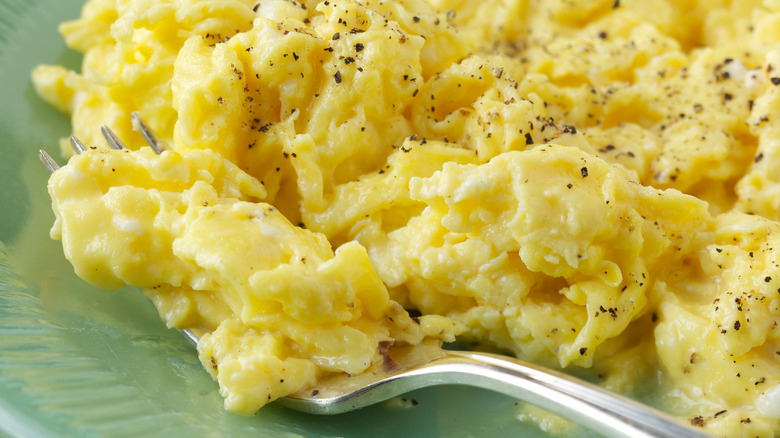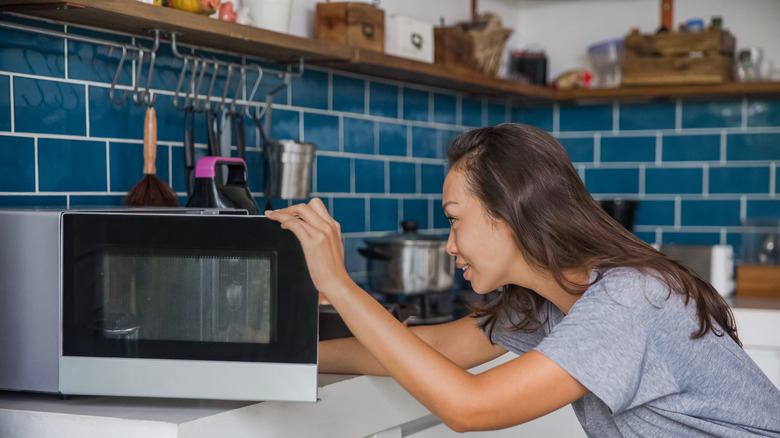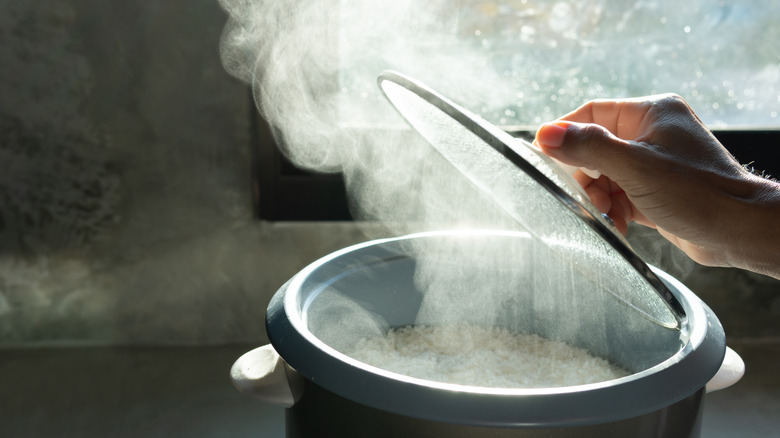16 Biggest Mistakes Everyone Makes With Scrambled Eggs
Scrambled eggs are always there when the craving strikes for a nutrient-dense, savory breakfast. Despite being available at nearly every diner and hotel breakfast bar, with its recipe easily found on many food-focused websites, we would venture to say that scrambled eggs are one of the trickiest recipes to make well. While it's easy to toss eggs in a skillet, turn up the heat, and render something palatable from it, it requires a mastery of the pan and technique to make ethereally soft and swoon-worthy scrambled eggs.
We've curated some of the most common mistakes people make with this breakfast food in the hope that you can trace when your plates of breakfast past have gone awry. We have also provided some tips along the way on how to master a good batch of scrambled eggs at home — rather than one you have to salvage with copious amounts of hot sauce.
Adding milk to your eggs
Think twice about putting milk in your scrambled eggs — this is one of the biggest mistakes that anyone can make with this dish, and many people don't even know that it is a mistake. After all, milk is a creamy ingredient that helps give other foods an unctuous and silky texture, so why wouldn't this be the case for eggs?
The main issue with adding this ingredient to your eggs, either as the mixture is cooking or before you've even cracked one into a bowl, is that it dilutes the dish. When there's more liquid swirling around in the pan, you may also be tempted to leave the eggs on the stove for a bit longer than you should, which in turn dries them out and imparts a rubbery texture. If you want to ensure that your eggs stay perfectly soft and creamy, cook them on low heat and skip any sort of liquid additions.
Scrambling your eggs in the pan
One crucial step when making scrambled eggs is beating the eggs in a separate bowl before transferring them to your hot skillet. We understand the aversion to dirtying a separate bowl and expending energy to beat eggs that are inevitably going to be stirred in the pan. But for fluffy eggs, you should take the extra time to stir your whites and yolks together in another container first.
The mechanical motion of stirring and breaking apart the proteins in the egg whites will help them hold air, similar to how whipping egg whites with a stand mixer is key to perfecting meringue. You have to be careful not to whip your eggs too much, which is why it's recommended to use a fork rather than a whisk. Balloon whisks may encourage too much air, which will leave your eggs rubbery and dense. Once your eggs are mixed sufficiently, meaning that you can't discern the yolks from the whites, pour the mixture into your pan and get cooking.
Trying to scramble eggs in water
Making scrambled eggs in the same manner as making egg drop soup isn't a new concept, even though videos on TikTok may make it seem like that's the case. This method involves stirring up a vortex in boiling water before slowly pouring in your eggs. The result is a web-like shape that may technically qualify as scrambled eggs, but it may not taste anything like the diner classic we know and love.
You should think twice before cooking scrambled eggs in boiling water, because this technique will not impart any flavor to your eggs. Rather, the water just serves to dilute your protein and wash away any seasoning that you added to your eggs before they went for a swim. Plus, these eggs come out so waterlogged and soggy that they will remind you of the moist, flavorless egg patty sandwiched within a McMuffin — and not in a good way.
Not trying brown butter scrambled eggs
Taking your scrambled eggs to the next level doesn't have to be complicated. You can try to make brown butter scrambled eggs to enhance the toasty qualities of your protein, and make the buttery undertones really stand out. Brown butter is made by evaporating the liquid from the butter and toasting the remaining milk solids. The smell and taste is more toffee-like, which makes the ingredient an excellent addition to baked goods, sauces, and more.
One of the biggest mistakes people make with this recipe is adding the eggs and the butter pats into the pan at the same time. Since the two ingredients don't cook at the same rate, you'll end up with hard eggs and butter that isn't quite toasty enough. Instead, make your brown butter first — then add the eggs once you notice a warm, toasty smell coming from your pan. It will only take a minute.
Salting your scrambled eggs too late
It's not a matter of whether or not to salt scrambled eggs, but when. The ideal time to add a sprinkle is right after you finish mixing but before you add the eggs to the hot pan. This timeframe will give the salt enough time to intersperse throughout the eggs and flavor the protein before it's cooked.
Chemically speaking, adding salt too late in the cooking process — such as when your eggs are already cooking away on the stove — will not produce the desired electrical charge of the proteins to the same degree as salting earlier. The longer the salt has to sit with the egg proteins, the longer the proteins will have to switch from a negative charge to a neutral one, thus more readily binding together for the perfect curdling.
If you are adding salt late in the game, your eggs won't have the same strength, and may even come out too loose and soggy. Properly timing your salting will also help the proteins in the egg yolk stay moist and creamy, which will ensure that your scrambled eggs come out fantastically soft rather than rubbery.
Forgetting to run your eggs through a sieve
It's essential to keep a sieve in your kitchen — and The French Laundry restaurateur Thomas Keller swears by this kitchen tool for smooth scrambled eggs. Handheld sieves are relatively cheap and an item everyone should have in their kitchen's odds-and-ends drawer.
The famed chef starts by mixing his eggs together with kosher salt before running the mixture through a sieve to ensure that it is thoroughly incorporated, and that there are no large blobs of yolk in it. Home cooks might not demand a French Laundry level of precision from their morning batch of eggs, but this tip is also helpful for anyone who manages to lose a piece of eggshell in seemingly every egg dish they've ever made. Keller finishes out his great plate of scrambled eggs by cooking it gently over medium-low heat, and adding a little bit of crème fraîche for creaminess and flavor.
Using only one type of cheese
We would argue that the best part about scrambled eggs isn't just the eggs — it's also the option to add a cheesy component to the dish. Your blend of cheeses will impart salty, savory, and umami elements to an otherwise bland breakfast.
You don't have to stick with a plain cheddar or plasticky American slice for this recipe, either. For example, chef Curtis Stone's scrambled eggs feature Gruyère cheese, which he folds into the mixture after the eggs are mostly cooked. This ensures that the cheese melts slightly but that the eggs don't have the chance to overcook.
You can also use ricotta cheese for the absolute creamiest scrambled eggs. This fresh cheese may not do much for adding savory or umami flavors, but it is certainly rich and buttery. You can add ricotta to your eggs when they are starting to solidify, but are not fully cooked through yet. Or, since this cheese is so wet, you could add it to the eggs when you're beating them in the bowl.
Using metal tools
Making anything in your kitchen is as much about the tools you use as it is about the ingredients. One particular material that never works well with eggs is metal. You should never use metal tools to make scrambled eggs — like your favorite stainless-steel frying pan and your trusty metal spatula — because the eggs will stick to them. However, you can use a cast iron skillet to make your scrambled eggs, but you'll need to be sure it's adequately coated with fat and preheated before you drop your eggs into it.
The ideal pan for making scrambled eggs is a nonstick one. Nonstick pans can lose their effectiveness with time and damage (like from metal utensils), so you're best off investing in a high-quality pan, or tossing your cheap pans when you notice the coating starting to dissipate. You can pair this pan with a sturdy silicon spatula, which will allow you to move the eggs around without scratching the pan.
Only using a spatula
Spatulas might be your go-to for preparing batches of scrambled eggs, but there's another utensil (or rather, pair of utensils) that can do the same work in your kitchen: chopsticks. You probably have a pair already, especially if you consider yourself a frequent flyer at your local Chinese takeout joint. Chopsticks are relatively easy to hold and won't scratch your nonstick pans, which makes them ideal for this recipe.
Like a fork, the chopsticks beat just enough air into the eggs to break the protein structures without overworking the eggs. Once your eggs are in the pan, use chopsticks to fold the corners of the barely set eggs, and gradually mix and stir until your eggs are cooked all the way through. (Even though it might be tempting to use the same chopsticks to eat your eggs once they're ready, we recommend grabbing clean dining utensils instead, as any residual raw eggs may make you sick.)
Stirring your eggs incorrectly
There's a method to everything in the kitchen — including making scrambled eggs. If you notice that your batch of scrambled eggs comes out flat, you may want to take a deeper look at how you're cooking the eggs once they hit the pan. Many people stir and flatten the eggs in the pan so that every little bit of the mixture touches the hot surface. Or, they are constantly and frantically moving the eggs around.
While this might seem like the right method, overworking the mixture might cause your eggs to come out of the pan dry. The better method is to take your spatula to the edge of the eggy mass and gently pull it towards the center heat. Then, once one side is done, move to the next side. This limits the amount of the mixture's spreading, and ensures that the egg is concentrated over the heat source.
Melting the butter
Imagine that you're getting ready to cook scrambled eggs. You grab the carton of eggs from the fridge, turn on the stove, and plop a pat of butter into the pan to melt. We're sorry to ruin your egg-filled daydream here, but actually you shouldn't melt the butter before cooking scrambled eggs. But we're not recommending that you get rid of butter entirely, since its fat coats the proteins and helps prevent overcooking.
Instead, start with cold, hard butter — if it's frozen, even better. Add the butter to the pan when you're ready to pour in the egg mixture to ensure that the two cook simultaneously. Chef J. Kenji López-Alt's process for creamy scrambled eggs combines this tip with a further step: He mixes small, cold butter cubes into the eggs, so that the pan's heat will be tempered with the cold fat. This may prevent your eggs from overcooking, and your breakfast will certainly come out buttery.
Setting your heat too high
If there is one saying that has proven true, not only in cooking but in life, it's that slow and steady wins the race. For example, if you try to melt chocolate at lightning speed, you will end up scorching it. Similarly, you should never rush when cooking scrambled eggs, either. If you crank up the burner, throw your eggs in, and hope for the best, you'll find that this mixture will always find a way to overcook. It's like the eggs can sense when you're experiencing a time crunch.
Take a step back, breathe, and turn that burner down. Once you add your eggs to the pan, set the burner to no higher than medium-low heat. In some cases, it may take upwards of half an hour (depending on what other additions you add to the pan) to ensure that your eggs stay soft and plush, rather than dry and overcooked. You'll know that your scrambled eggs are ready to get pulled from the heat when the mixture is thick (not dry) and there is no liquid swirling around.
Neglecting a cooling ingredient
Scrambled eggs are a relatively simple recipe, but that doesn't mean you can't add enhancements to improve the flavor. For example, chef and author Jacques Pépin's trick for making extra smooth scrambled eggs is to first set aside some of the raw egg mixture before cooking the rest of it, and later whisk the cooked eggs with the reserved raw-egg mixture and some heavy cream. The temperature contrast, along with removing the eggs from the pan, will ensure that the mixture doesn't overcook. Plus, adding these creamy elements won't mess with the protein structure of the eggs and prevent them from coming together.
There are many other cooling ingredients to add to your eggs. If you're after fluffiness, scrambled eggs can be made fresh and velvety with sour cream. This is a great tip for working with a large quantity of eggs, as it will keep them super soft and impart a balancing tartness to the protein. Similarly, Bobby Flay gets the creamiest scrambled eggs with a dollop of crème fraîche — which is the perfect add-in for a decadent breakfast.
Serving your eggs on a cold plate
You mean to tell us you'd go through all the hard work of mixing, cooking, and flavoring your eggs — only to serve them on a cold plate? It's disappointing, and it's even more troubling to think that many home cooks have never considered how important it is to serve hot food on a hot (or at least warm) plate. Alton Brown's simple trick for keeping scrambled eggs warm is to heat up your plate before putting your scramble on it.
Temperature can really alter the way we perceive food, and a cold plate of eggs isn't anywhere near as appetizing as a piping hot one. Try soaking your plates in a container of hot water, and then dry them just before you're ready to serve. Or, put your plates in the oven on low to bring them up to temp. This trick seems small, but it will make all the difference for your meal.
Zapping all the moisture out of your leftover eggs
Leftover eggs have about the same reputation as airplane food. There's nothing wrong with eating reheated scrambled eggs. Rather, the issue is that when people reheat a batch of scrambled eggs, they often overcook them, which turns them rubbery — even if the eggs started out perfectly cooked.
You'll need to bring your eggs up to 165 degrees Fahrenheit before you can chow down safely. But don't just throw your eggs in a microwave-safe bowl for a few minutes and walk away. Instead, you'll need to gently bring the eggs up to temperature by steaming them with water. Of course, pour out the liquid before eating, since watery eggs aren't any more appealing than dry ones. The better way to reheat eggs, though, is to put them in a sealable bag and sink it in a hot water bath for about 10 minutes.
Thinking you have to cook scrambled eggs on a stove
A stove is a logical go-to device for cooking scrambled eggs. But there are also other ways to make delicious scrambled eggs without a stove. One of the first techniques that comes to mind is using a rice cooker. You can whip up your eggs and seasonings, put them in the pot, and turn the heat on a low setting. It's just as easy to overcook the eggs on a stove as it is in a rice cooker, so avoiding the highest setting is ideal to ensure that your eggs stay soft and fluffy. Once your eggs have started to cook, you can open the top, turn them with a spatula, and cook them until they reach your desired degree of doneness.
You can also make fluffy scrambled eggs in an air fryer. Pour your beaten eggs into a nonstick, heat-safe dish, and place it into your pre-heated air fryer. After every couple of minutes, take your basket out and stir your eggs before returning them to the appliance to continue cooking.
